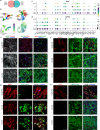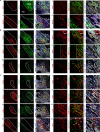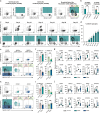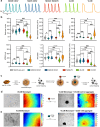Single-cell transcriptome analysis reveals CD34 as a marker of human sinoatrial node pacemaker cardiomyocytes
- PMID: 39604360
- PMCID: PMC11603134
- DOI: 10.1038/s41467-024-54337-4
Single-cell transcriptome analysis reveals CD34 as a marker of human sinoatrial node pacemaker cardiomyocytes
Abstract
The sinoatrial node regulates the heart rate throughout life. Failure of this primary pacemaker results in life-threatening, slow heart rhythm. Despite its critical function, the cellular and molecular composition of the human sinoatrial node is not resolved. Particularly, no cell surface marker to identify and isolate sinoatrial node pacemaker cells has been reported. Here we use single-nuclei/cell RNA sequencing of fetal and human pluripotent stem cell-derived sinoatrial node cells to reveal that they consist of three subtypes of pacemaker cells: Core Pacemaker, Sinus Venosus, and Transitional Cells. Our study identifies a host of sinoatrial node pacemaker markers including MYH11, BMP4, and the cell surface antigen CD34. We demonstrate that sorting for CD34+ cells from stem cell differentiation cultures enriches for sinoatrial node cells exhibiting a functional pacemaker phenotype. This sinoatrial node pacemaker cell surface marker is highly valuable for stem cell-based disease modeling, drug discovery, cell replacement therapies, and the targeted delivery of therapeutics to sinoatrial node cells in vivo using antibody-drug conjugates.
© 2024. The Author(s).
Conflict of interest statement
Competing interests: S.P. is a paid consultant for BlueRock Therapeutics LP. M.A.L. is a scientific founder and paid consultant for BlueRock Therapeutics LP. G.D.B. is a paid advisor of Adela, Inc.. A.A.L., M.L., and S.P. declare a patent titled “Use of CD34 as a marker for sinoatrial node-like pacemaker cells” (PCT/IB2021/053646) related to this study. All other authors declare no competing interests.
Figures









References
-
- Cantillon, D. J. et al. Complications and health care costs associated with transvenous cardiac pacemakers in a nationwide assessment. JACC Clin. Electrophysiol.3, 1296–1305 (2017). - PubMed
-
- Christoffels, V. M., Smits, G. J., Kispert, A. & Moorman, A. F. Development of the pacemaker tissues of the heart. Circ. Res.106, 240–254 (2010). - PubMed
-
- Sizarov, A. et al. Molecular analysis of patterning of conduction tissues in the developing human heart. Circ. Arrhythm. Electrophysiol.4, 532–542 (2011). - PubMed
-
- van Eif, V. W. W. et al. Transcriptome analysis of mouse and human sinoatrial node cells reveals a conserved genetic program. Development146, dev173161 (2019). - PubMed
-
- Chandler, N. J. et al. Molecular architecture of the human sinus node: insights into the function of the cardiac pacemaker. Circulation119, 1562–1575 (2009). - PubMed
Publication types
MeSH terms
Substances
Associated data
- Actions
- Actions
- Actions
Grants and funding
- CIHR PJT 169090/Gouvernement du Canada | Canadian Institutes of Health Research (Instituts de Recherche en Santé du Canada)
- Doctoral Fellowship/Gouvernement du Canada | Canadian Institutes of Health Research (Instituts de Recherche en Santé du Canada)
- Doctoral Fellowship/Gouvernement du Canada | Canadian Institutes of Health Research (Instituts de Recherche en Santé du Canada)
- Postdoctoral Fellowship/Gouvernement du Canada | Canadian Institutes of Health Research (Instituts de Recherche en Santé du Canada)
LinkOut - more resources
Full Text Sources
Molecular Biology Databases

